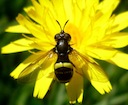 The striking wasp-mimic hoverfly Chrysotoxum bicinctum is found in grassy places and more open areas in woodland.
The striking wasp-mimic hoverfly Chrysotoxum bicinctum is found in grassy places and more open areas in woodland.
Photo: Andy Pay
Scientific name: Chrysotoxum bicinctum
Common name: Most hoverflies don’t have a common name. In America, hoverflies are known as flower flies.
What to look for:
- Colouring: This hoverfly has the yellow and black banding of a wasp-mimic. It has two obvious yellow bands on its abdomen and yellow markings on the sides of its thorax. The chocolate-brown colour of the leading edge of its wings is distinctive.
- Size: 10 to 13 mm.
- Where: Open grassy areas, scrub or well-lit woodland rides. It is widespread, although more common in the south than the north of Britain.
- Similar species: It could be confused with the hoverfly Dasysyrphus tricinctus, but the latter lacks the chocolate colouring on the wings and yellow thorax markings.
 Although a fair number of hoverflies in Britain are black in colour, we generally associate this family (Syrphidae) of the true flies (Order: Diptera) with the yellow and black or amber hues of wasp and bee mimicry (known as Batesian mimicry). From spring to early autumn, hoverflies are a common sight collecting nectar and pollen from wildflowers in meadows, woodland and in our own gardens. As the family name suggests, they are experts at hovering, and can hold their head completely still while feeding on the wing. Adults generally live only for a number of days to a few weeks, and use that time to feed, mate and for the females to lay eggs.
Although a fair number of hoverflies in Britain are black in colour, we generally associate this family (Syrphidae) of the true flies (Order: Diptera) with the yellow and black or amber hues of wasp and bee mimicry (known as Batesian mimicry). From spring to early autumn, hoverflies are a common sight collecting nectar and pollen from wildflowers in meadows, woodland and in our own gardens. As the family name suggests, they are experts at hovering, and can hold their head completely still while feeding on the wing. Adults generally live only for a number of days to a few weeks, and use that time to feed, mate and for the females to lay eggs.
The striking Chrysotoxum bicinctum (most hoverflies don’t have a common name) is a wasp-mimic of grassland and the rides and edges of woodland, flying between May and September. We don’t actually know much about the behaviour of its larvae, but the species is thought to be associated with ants’ nests, in which the hoverfly larvae possibly feed on the root aphids being farmed by the ants for their honeydew. This leaves many unanswered questions: how do the larvae access the ants’ nest, and why don’t the ants attack the hoverfly larvae (Ball & Morris, 2013)?
Did you know…?
…An average of one new hoverfly species per year is added to the number of those found in Britain (281 in 2013; Ball & Morris, 2013).
…Hoverflies are generally welcomed by gardeners because the larvae of some species gobble up aphids, but the larvae of two – the Lesser Bulb Fly and Greater Bulb Fly – are not so garden-friendly, as they attack flower bulbs.
More information and references:
Ball, S. and Morris, R., 2013. Britain’s Hoverflies: an Introduction to the Hoverflies of Britain. Princeton University Press, Woodstock, Oxfordshire.
Chinery, M., 2004. Collins Complete Guide to British Insects. Collins, London.
Published: June 2014
Author: Amanda Scott
Photos: Andy Pay
